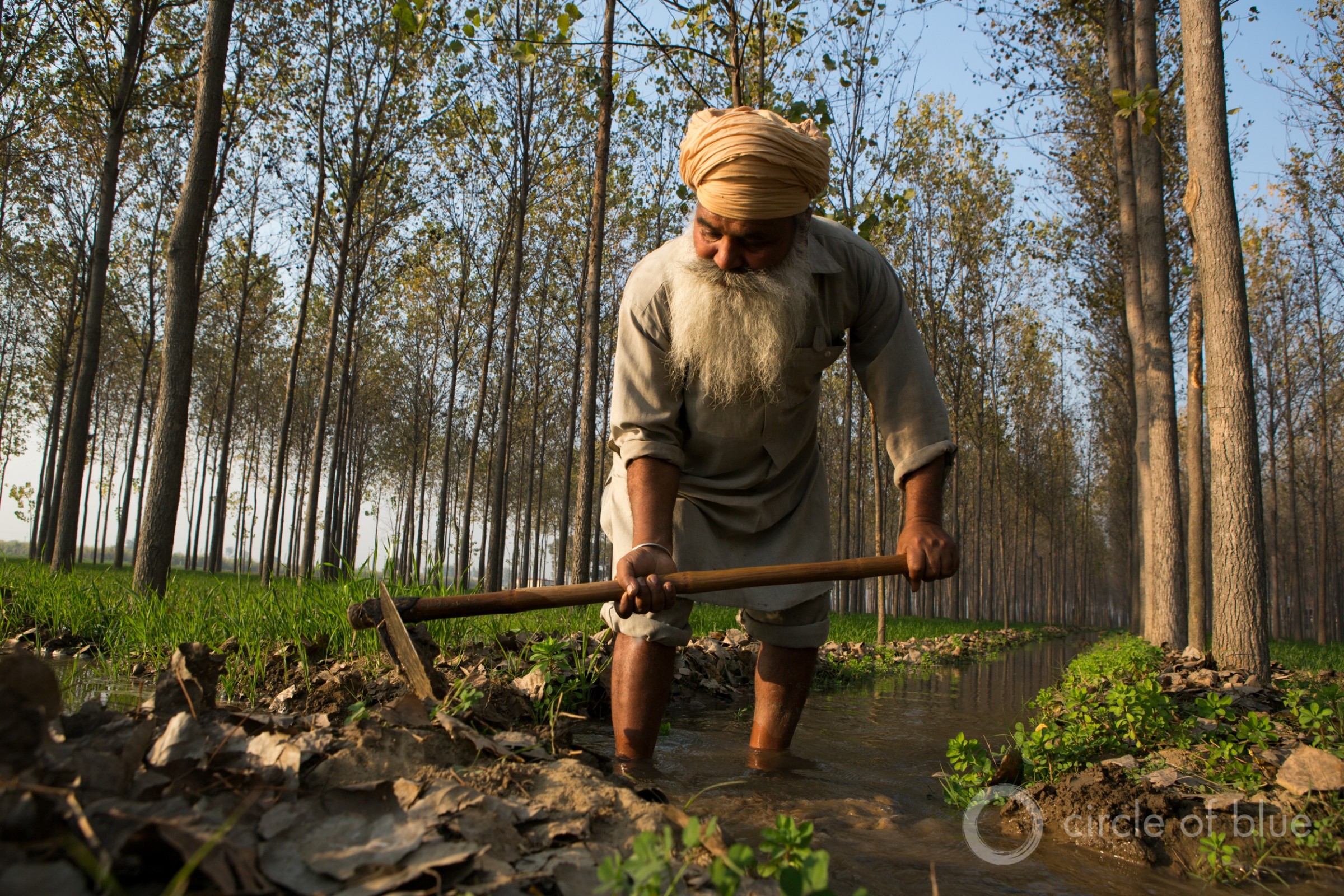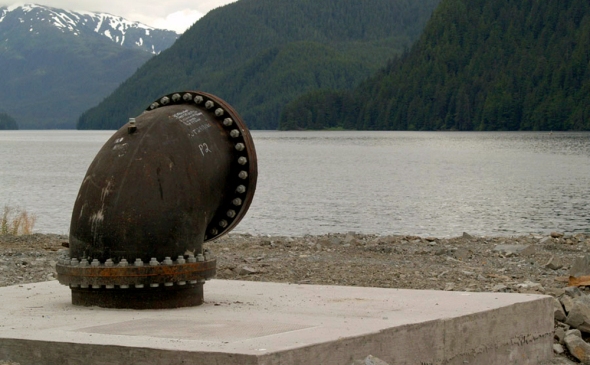India Has Water for Its Economic Plans – If Farms Can Be More Thrifty
India’s farmers are key to the country’s industrial future, think-tank report finds.

Desraj Khai works paddies of rice and wheat that grow beneath stands of aspen in India’s northwestern state of Punjab. Photo © J. Carl Ganter/Circle of Blue
By Brett Walton, Circle of Blue
India’s leaders have ambitious goals for the country’s economy, aiming with the Make in India campaign to lift the manufacturing sector to a place of prominence.
To do that, they will have to answer what Vaibhav Chaturvedi says is one of the country’s biggest policy questions: how to reduce water use by farmers.
Farming is where the water is in India, accounting for nearly 80 percent of the country’s water withdrawals. Farming is also where the labor is, employing more than two in five workers. Even with this arsenal, India’s farmers are some of the world’s least efficient users of water, and conflicts over water supplies are a frequent occurrence in a country beset by stifling heat, rampant groundwater depletion, diminishing reservoirs, and 1.4 billion people.
“We’re foreseeing that the conflicts that were experienced in the last five years will intensify,” Chaturvedi told Circle of Blue.
Chaturvedi is a fellow at the Council on Energy, Environment, and Water, one of the country’s most respected environmental policy think tanks. In his eyes, water waste in agriculture is a failure of policy and practice. But it also presents an opportunity. He and his colleagues describe the potential gains in a report on more-efficient water use.
“Overall, the implication is clear — if India wants to sustain its current growth levels or achieve a higher level of per capita GDP, it needs to reduce the water intensity of its economy, make water available for other sectors, and avoid impending water shortages and associated conflicts,” the report states.
The question is a matter of tradeoffs, the authors argue. If India’s least-efficient farmers could match their thriftier peers — getting the same amount of crop but by using far less water to do it — there would be a hydrological dividend. That extra water could restore degraded ecosystems, or it could be transferred to the manufacturing sector, where drops of water result in products with a higher market value than those from farming.
In this scenario there would be no net change in agricultural production. But the extra water would facilitate more manufacturing output – and less environmental damage that would occur if factories extracted more water from overtapped aquifers and rivers, or if more dams were constructed.
The gains are not just theoretical. The goal of the study was to use real-world examples to quantify how much water could be saved without reducing farm output. The report did this by measuring the water-use performance of the best farmers in three states — Andhra Pradesh, Maharashtra, and Uttar Pradesh — and comparing them with the laggards. The comparisons were made for each of eight key crops, including pulses, sugarcane, cotton, and rice.
The potential for water savings varies by crop and state. Water use for sugarcane could decrease by 20 percent in Uttar Pradesh and by 36 percent in Maharashtra, which is the more water-stressed state.
But overall, large gains could be had. In a low-savings scenario, where all farmers are brought up to average performance, water withdrawals could be reduced by 20 percent. In a high-savings scenario, in which all farmers achieve top-tier efficiency, withdrawals are cut by 47 percent. That water could be redirected to industry and to households, as India aims to expand piped water service to all rural households by 2024.
The large potential savings were not surprising, Chaturvedi said. The value of the study instead was narrowing down the range by using real-world data. “The general story, everyone knows,” he said. “What was not known was the potential.”
What is preventing India’s worst-performing farmers from being more efficient with their water? Highly efficient irrigation is standard for specialty crops in Israel and parts of the United States. Soil probes indicate when moisture is low and irrigation is required. Irrigation schedules are planned around rain events. Sprinklers and drip systems apply the water a crop needs and little more.
Chaturvedi said that in India’s case much of the blame rests on outdated policies and practices. Farms that irrigate fields by flooding them, for instance, lose much water to evaporation. Government-subsidized electricity encourages overpumping of groundwater. And minimum market prices set by the government result in water-hungry rice being grown in arid Punjab, where the average farmer uses more than twice the water to grow a kilogram of rice than a counterpart in rainier West Bengal.
Murtaza Hasan, principal scientist at the Indian Agricultural Research Institute, told Circle of Blue that improving the water productivity of Indian agriculture is “urgently required.” Shifting from “water-guzzling” crops like sugarcane and rice to those that use less water is something that should happen as soon as possible.
But Hasan was more cautious about immediately shifting that water to industrial use. That should happen only after the appropriate policies are in place, he said.
Chaturvedi said the next step for his group is to look more deeply at those policies, and see which levers are most suitable — economically, administratively and politically — in a particular state. Pilot programs in small watersheds could test the strategies before being expanded. If all goes well, the outcome would be wiser use of water across the country — and less risk of conflict.
Brett writes about agriculture, energy, infrastructure, and the politics and economics of water in the United States. He also writes the Federal Water Tap, Circle of Blue’s weekly digest of U.S. government water news. He is the winner of two Society of Environmental Journalists reporting awards, one of the top honors in American environmental journalism: first place for explanatory reporting for a series on septic system pollution in the United States(2016) and third place for beat reporting in a small market (2014). He received the Sierra Club’s Distinguished Service Award in 2018. Brett lives in Seattle, where he hikes the mountains and bakes pies. Contact Brett Walton







Leave a Reply
Want to join the discussion?Feel free to contribute!